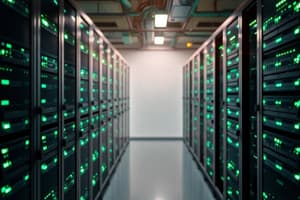Podcast
Questions and Answers
What is the primary responsibility of a network administrator?
What is the primary responsibility of a network administrator?
- Manage user accounts and access permissions.
- Design and implement network infrastructure.
- Develop network security protocols.
- Ensure the network is operational and functioning correctly. (correct)
What are the five key components of a network management architecture?
What are the five key components of a network management architecture?
- Router, switch, firewall, intrusion detection system, and network monitoring tools.
- Network manager, managed devices, MIBs, agents, and communication protocol. (correct)
- Hub, bridge, switch, router, and gateway.
- Physical layer, data link layer, network layer, transport layer, and application layer.
What does MIB stand for in the context of network management?
What does MIB stand for in the context of network management?
- Media Independent Block.
- Management Information Base (correct)
- Management Interface Block
- Multicast Information Block
What type of communication protocol is typically used between a network manager and managed devices?
What type of communication protocol is typically used between a network manager and managed devices?
Which of the following is NOT a reason why network administrators need tools to manage a network?
Which of the following is NOT a reason why network administrators need tools to manage a network?
What is a network operations center (NOC)?
What is a network operations center (NOC)?
What is the role of a remote agent in network management?
What is the role of a remote agent in network management?
Which of the following is NOT discussed in the context of network management in this excerpt?
Which of the following is NOT discussed in the context of network management in this excerpt?
What is the main purpose of monitoring for SLAs?
What is the main purpose of monitoring for SLAs?
Why is it important for a network administrator to detect route flapping?
Why is it important for a network administrator to detect route flapping?
What is the primary function of performance management in network administration?
What is the primary function of performance management in network administration?
How can a network administrator detect a potential network security threat?
How can a network administrator detect a potential network security threat?
When would a network administrator want to be notified about high congestion levels on a network link?
When would a network administrator want to be notified about high congestion levels on a network link?
What kind of network management area would focus on quantifying the performance of individual network devices?
What kind of network management area would focus on quantifying the performance of individual network devices?
What is the primary benefit of monitoring for traffic originating from or destined to suspicious sources?
What is the primary benefit of monitoring for traffic originating from or destined to suspicious sources?
Which of the following is NOT a performance metric typically included in an SLA?
Which of the following is NOT a performance metric typically included in an SLA?
What is the primary goal of Fault Management in network management?
What is the primary goal of Fault Management in network management?
Which of the following is NOT typically considered a core component of network management?
Which of the following is NOT typically considered a core component of network management?
How does the SNMP protocol contribute to Fault Management?
How does the SNMP protocol contribute to Fault Management?
What differentiates Fault Management from Performance Management?
What differentiates Fault Management from Performance Management?
Which of the following is an example of a component used in Security Management?
Which of the following is an example of a component used in Security Management?
What is the primary function of Configuration Management within network management?
What is the primary function of Configuration Management within network management?
What does Accounting Management involve in network administration?
What does Accounting Management involve in network administration?
Which of the following is NOT directly addressed in the provided content about network management?
Which of the following is NOT directly addressed in the provided content about network management?
What is the primary function of a managing entity in network management?
What is the primary function of a managing entity in network management?
What serves as the counterpart to a branch office manager in a network management architecture?
What serves as the counterpart to a branch office manager in a network management architecture?
According to the passage, what is a key similarity between human organizational management and network management?
According to the passage, what is a key similarity between human organizational management and network management?
What is the primary role of the network management protocol in this context?
What is the primary role of the network management protocol in this context?
How does the analogy of a branch office manager's motivation to advance their career relate to network management?
How does the analogy of a branch office manager's motivation to advance their career relate to network management?
What is the primary benefit of using a network management system?
What is the primary benefit of using a network management system?
What is the key difference between unsollicited reports from branch office managers and standard reports?
What is the key difference between unsollicited reports from branch office managers and standard reports?
What does the term 'executive order' represent in this context?
What does the term 'executive order' represent in this context?
Which of the following is NOT considered a managed device in the context of network management?
Which of the following is NOT considered a managed device in the context of network management?
What is the primary purpose of a network management agent within a managed device?
What is the primary purpose of a network management agent within a managed device?
Which of the following best describes the relationship between a managing entity and a managed device?
Which of the following best describes the relationship between a managing entity and a managed device?
In the analogy presented, what component is represented as the 'branch office' in a network management system?
In the analogy presented, what component is represented as the 'branch office' in a network management system?
Which of the following is NOT a key element typically found within a managed device?
Which of the following is NOT a key element typically found within a managed device?
What is the primary purpose of the management information base (MIB) within a managed device?
What is the primary purpose of the management information base (MIB) within a managed device?
Based on the information provided, which of the following would be considered managed objects?
Based on the information provided, which of the following would be considered managed objects?
A human network administrator primarily interacts with which component of the network management system?
A human network administrator primarily interacts with which component of the network management system?
Which of the following is NOT a key component of a network management architecture as described in the text?
Which of the following is NOT a key component of a network management architecture as described in the text?
The text explains that SNMP emerged as a widely used network management framework. Which of the following is a primary reason for SNMP's popularity?
The text explains that SNMP emerged as a widely used network management framework. Which of the following is a primary reason for SNMP's popularity?
What is the primary role of agents in the network management architecture described in the text?
What is the primary role of agents in the network management architecture described in the text?
The text uses the analogy of a typical organizational structure to illustrate the concept of network management. In this analogy, what is the equivalent of the 'managing entity' in a real-world organization?
The text uses the analogy of a typical organizational structure to illustrate the concept of network management. In this analogy, what is the equivalent of the 'managing entity' in a real-world organization?
What is the primary function of the 'management information base' (MIB) mentioned in the text?
What is the primary function of the 'management information base' (MIB) mentioned in the text?
Which of the following best describes the function of a network management protocol?
Which of the following best describes the function of a network management protocol?
The text mentions the emergence of network management standards in the late 1980s. Which of the following is NOT mentioned as a prominent network management standard in the text?
The text mentions the emergence of network management standards in the late 1980s. Which of the following is NOT mentioned as a prominent network management standard in the text?
The text emphasizes a specific distinction regarding the role of the network management protocol. What is this distinction?
The text emphasizes a specific distinction regarding the role of the network management protocol. What is this distinction?
Flashcards
Network Management
Network Management
The practice of monitoring and controlling network components and resources.
Network Manager
Network Manager
The individual responsible for overseeing and maintaining the network operation.
Managed Remote Devices
Managed Remote Devices
Devices within the network that can be monitored and controlled by the network manager.
Management Information Base (MIB)
Management Information Base (MIB)
Signup and view all the flashcards
Remote Agents
Remote Agents
Signup and view all the flashcards
SNMP Protocol
SNMP Protocol
Signup and view all the flashcards
Packet Filtering
Packet Filtering
Signup and view all the flashcards
Application-Level Gateways
Application-Level Gateways
Signup and view all the flashcards
Congestion notification
Congestion notification
Signup and view all the flashcards
Route flapping
Route flapping
Signup and view all the flashcards
Service Level Agreements (SLA)
Service Level Agreements (SLA)
Signup and view all the flashcards
Performance metrics
Performance metrics
Signup and view all the flashcards
Intrusion detection
Intrusion detection
Signup and view all the flashcards
Traffic filtering
Traffic filtering
Signup and view all the flashcards
Performance management
Performance management
Signup and view all the flashcards
Network management model
Network management model
Signup and view all the flashcards
Fault Management
Fault Management
Signup and view all the flashcards
Simple Network Management Protocol (SNMP)
Simple Network Management Protocol (SNMP)
Signup and view all the flashcards
Configuration Management
Configuration Management
Signup and view all the flashcards
Accounting Management
Accounting Management
Signup and view all the flashcards
Security Management
Security Management
Signup and view all the flashcards
Network Operations Center (NOC)
Network Operations Center (NOC)
Signup and view all the flashcards
Proactive Anomaly Detection
Proactive Anomaly Detection
Signup and view all the flashcards
Managing Entity
Managing Entity
Signup and view all the flashcards
Managed Device
Managed Device
Signup and view all the flashcards
Network Management Protocol
Network Management Protocol
Signup and view all the flashcards
Branch Office Reports
Branch Office Reports
Signup and view all the flashcards
Communication Protocols
Communication Protocols
Signup and view all the flashcards
Problem Identification
Problem Identification
Signup and view all the flashcards
Executive Order
Executive Order
Signup and view all the flashcards
Sifting Through Reports
Sifting Through Reports
Signup and view all the flashcards
Managed Objects
Managed Objects
Signup and view all the flashcards
Network Management Agent
Network Management Agent
Signup and view all the flashcards
Data Communication
Data Communication
Signup and view all the flashcards
Control Actions
Control Actions
Signup and view all the flashcards
Managing Agent
Managing Agent
Signup and view all the flashcards
Exceptional Events
Exceptional Events
Signup and view all the flashcards
SNMP
SNMP
Signup and view all the flashcards
Network Management Standards
Network Management Standards
Signup and view all the flashcards
Study Notes
Network Management
- Network management entails tools for monitoring, testing, configuring, analyzing, evaluating, and controlling network operations.
- Key components of a network management architecture include: a network manager, managed remote devices, management information bases (MIBs), remote agents (reporting and acting per manager's instructions), and a protocol for communication.
- Internet Network Management Framework and SNMP protocol are detailed components of network management.
- ASN.1 is a structured way to define data types used in network management.
- The network administrator's job is to maintain network functionality and operation.
- Network malfunctions (cable cuts, device failures) frequently occur and must be addressed by the network administrator.
- Monitoring, managing, and controlling large networks requires appropriate tools.
Network Management Scenarios
- Real-world examples like control rooms monitoring power plant components or airplane cockpits illustrate the importance of monitoring, management, and control within complex systems.
- Administrators in these contexts react to problems and proactively manage the system's performance.
Network Management Tools
- Network management tools are critical in identifying and resolving network issues, especially within large, distributed networks.
- Tools enable proactive problem identification (like failing interfaces) before issues affect users.
- Tools allow monitoring of network traffic for potential problems.
- Tools assist in managing large networks, enabling administrators to react quickly to changing conditions.
Network Management Components
- Managing entities—in charge of the overall network state—reside in a central location, often a Network Operations Center (NOC).
- A managed device is any piece of network hardware in use.
- A network management agent runs on or within a managed device.
- The agent helps communicate with the managing entity and complete local management tasks.
- A network management protocol acts as the communication channel between the managing entity and the managed devices.
Key Network Management Protocols
- Simple Network Management Protocol (SNMP) is frequently used for collecting and organizing information about managed devices and to alter their behavior on an IP network. Key parts/components of SNMP include managed devices, agents and network management systems (NMSs).
Network Management Information
- Understanding network configuration details (processor type, size of hard drive, and RAM) is crucial for management.
- Administrators use network management software for a detailed view of hardware and software, and to manage resources.
- Management Information Bases (MIBs) hold information about the managed devices in a network, describing how to manage them.
- The managing entity uses data from monitoring systems and from managed devices to diagnose and resolve network issues.
Key Considerations In Network Design
- It is important to plan before implementing a network.
- Pre-emptive planning will be crucial in identifying/mitigating potential issues.
- Purpose and scope of the network need clarification before any implementation begins.
- Use of a dedicated server is important for complex or significant needs, rather than a peer-to-peer model.
- The choice of a dedicated server needs to be suitable to the network's needs.
- There are many types of servers that can be used, for example file servers, print servers, web servers, and mail servers.
Studying That Suits You
Use AI to generate personalized quizzes and flashcards to suit your learning preferences.




